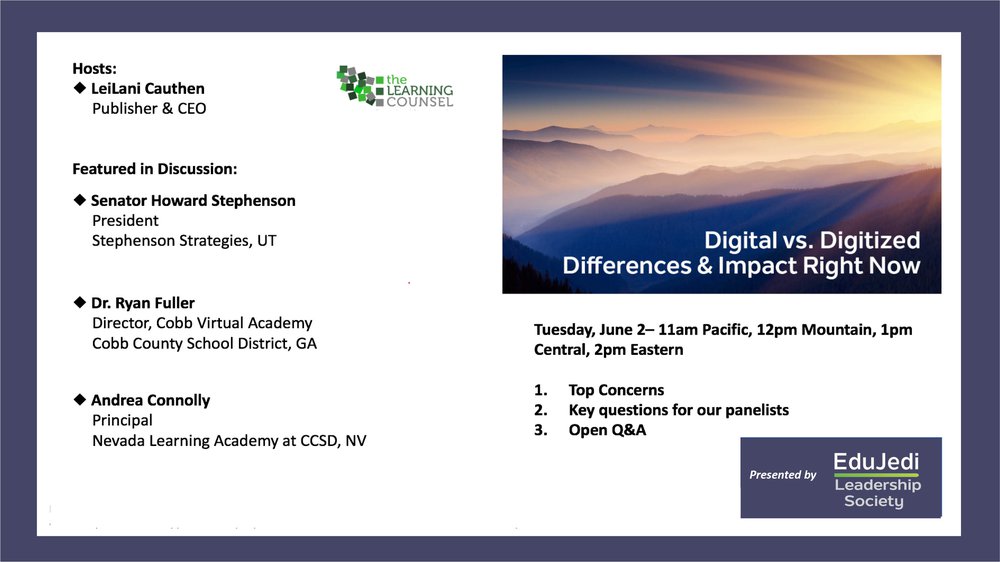As we reopen our schools, everything seems to be on the table. The question of using true digital, professional-grade courseware vs. digitized, often teacher-created curriculum is an important one. In this episode of the Learning Counsel’s Dawn of New Strategies virtual discussions, you’ll hear some of our nation’s top digital experts discuss the pros and cons of this question in the shadow of the COVID-19 crisis.
According to LeiLani Cauthen, CEO and Publisher at the Learning Counsel, “When you look at curriculum planning the way it's done in states, and that way it's always been done, is you have the standards framework up at the top. Then districts and schools set up their pacing guides, which is general guidance on when you would teach math fractions or any sort of concept against the calendar map. And finally, at the teaching level, that's where all the work gets done to put it all together. And that may not be sufficient for this age of having to go remote and hybrid with everything. There are many, many choices. If you've tried a Google around on the Internet, you're going to find out it's millions and millions of things. Now, the impact. More instructional planning is required of your teachers. If you're sticking to whole group, where digital is coming into play is to take some of that burden off.
“The mix is entirely up to you as an individual teacher or your school, how you're going to reduce the burden on teaching so that you can actually do things remotely and become hybrid. And the more automated learning you get, the more you get into algorithms and how things are actually distributing knowledge. And it takes a lot of studying to figure those out inside those systems, because you're not just looking at an individual digitized bit of knowledge. You're looking at true digital, which is a different animal.”
Senator Howard Stephenson is a state senator in the Utah State Legislature and President, Stephenson Strategies. The senator said, “I've been involved in the Utah legislature for 26 years, mostly advancing education reform and what I've learned through those years, and especially in the last 15 years of focusing on digital teaching and learning is that the digital teaching and learning river is a mile wide and an inch deep. And the problem with it is that you can't see from the surface, which areas are actually a mile deep. And there are those areas that can actually get 90 percent of any class in math and reading at grade level proficiency in a single academic year if the teacher learns to use the tools with fidelity and allow the high quality interactive adaptive software to do the primary teaching of math and reading concepts.”
Dr. Ryan Fuller is the Director at Cobb Virtual Academy, a part of the Cobb County School District. Cobb County Virtual Academy has been in existence for 20 years, and Fuller has a unique take on digital. “Digital is really a state of mind, a way of thinking. And from our perspective, when we talk about digital learning, we really simplify the core of education. We want to know the four basic questions. What do we want students to know? How do we know when they know it? What do we do when they don't know it? And then what do we do when they do know it? And the digital thinking then allows us to really approach these four basic questions in education and solve them in new ways.”
Andrea Connolly is the Principal at Nevada Learning Academy at Clark County School District in Nevada. According to Connolly, “What it comes down to with us is the relationships and the engagement of the teachers with the students. And that's where we try to make sure that the students still feel they're part of the school and part of the class, because otherwise you do get the students that disappear, that are lost. And especially in these trying times, one of the first things we tried to do was set up weekly sessions where students that they just wanted to talk. We really have to be aware of the person behind the student so that we can support their academics. How can we support the student and still meet the needs of all the resources and the digital access we talked about? There's so much out there right now. And a lot of it was free for now, but it won't be free forever. So how do you decide what's the best for the content? Well, also it's supporting the person, the student.”
Watch the video
Digital vs. digitized? There are countless choices, and it comes down to two factors: What best meets the needs of students during this unique time, and what allows our teachers to do what they do best, be human and connect with students. With millions and millions of options, it seems that less is more as we rebuild our education system from the ravages of the pandemic. These education leaders are asking the right questions, and their experience can help you answer your questions as well.











